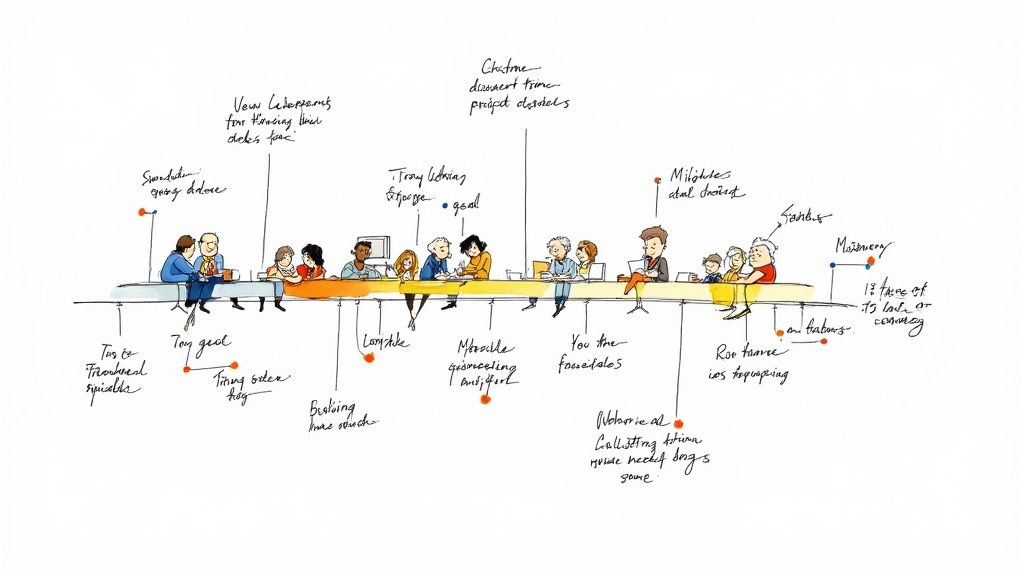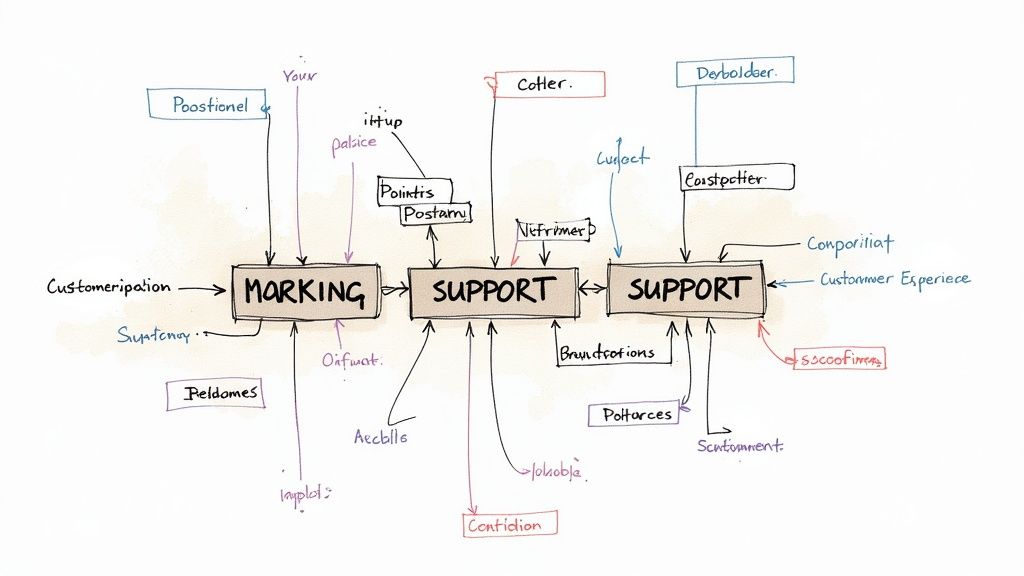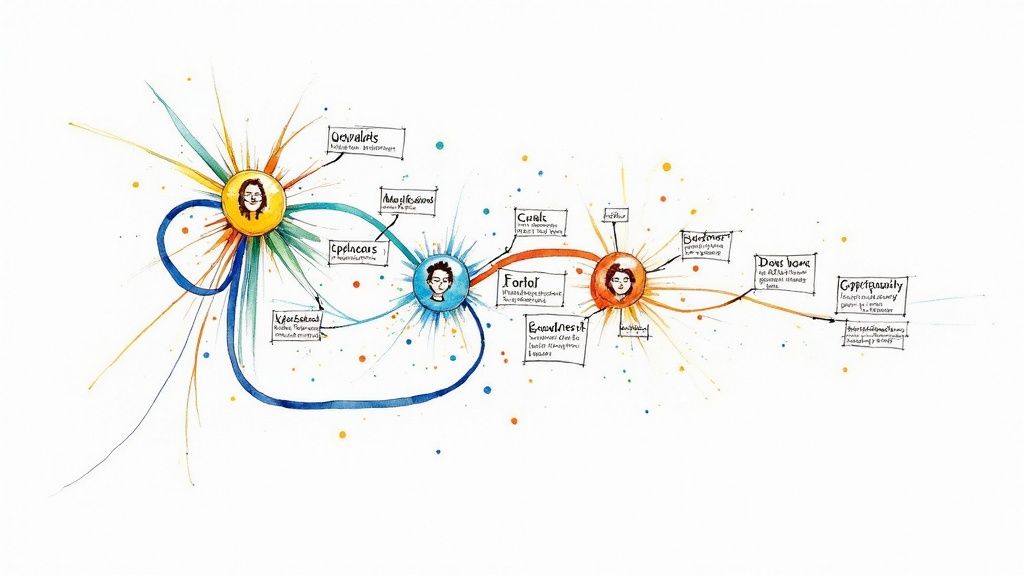The Ultimate Customer Experience Mapping Template: A Step-by-Step Guide
Transform your customer experience strategy with proven mapping techniques that drive measurable results. Learn from industry experts and discover practical approaches to creating journey maps that enhance satisfaction and loyalty.
- 9 min read

Understanding Customer Experience Mapping Fundamentals

Great customer experiences drive business success. Companies need to create positive interactions at every step of a customer's journey with their brand. That's why customer experience mapping has become essential. A mapping template helps businesses visualize and analyze how customers engage with their products and services, spot problems, and find ways to improve.
Why Customer Experience Mapping Matters
This isn't just another business tool - it's a practical way to turn customer data into real improvements. By mapping the customer journey, companies can better grasp what drives customer behavior and emotions. When you understand these factors, you can develop specific fixes that boost satisfaction and encourage loyalty. For instance, if customers frequently complain about long phone wait times, that's a clear signal to improve your support process.
Customer experience mapping gained momentum alongside Customer Experience Management (CEM) in the early 2000s. By 2013, it had become a core business practice. Organizations like Demand Metric developed detailed toolkits to help companies track and understand customer feelings throughout their journey.
Key Benefits of Utilizing a Customer Experience Mapping Template
A well-designed mapping template helps businesses:
- Track Every Interaction: Map out all customer touchpoints from first contact to post-purchase
- Understand Customer Feelings: See how customers react emotionally at each stage
- Keep Customers Longer: Fix problems that cause customers to leave
- Build Better Products: Use customer insights to guide product improvements
- Fix Internal Issues: Find and fix company processes that hurt the customer experience
Getting Started With Customer Experience Mapping
While creating a customer experience map might seem complex, templates make it manageable. A customer experience mapping template gives you a clear structure to record key information about your customers' journey. Good templates include spaces for:
- Customer Profiles: Who are your target customers?
- Journey Steps: What path do customers take?
- Contact Points: Where do customers interact with your business?
- Customer Feelings: How do customers feel at each step?
- Problem Areas: What frustrates your customers?
- Room for Growth: Where can you make things better?
Using a template ensures you capture all the important details systematically. This organized approach helps teams focus on what matters most - creating better experiences for customers.
Essential Components of an Effective Experience Map
A customer experience map helps businesses understand how customers interact with their brand. It goes beyond just listing touchpoints to reveal deeper insights about customer behavior, needs, and feelings at each stage of their journey.
Defining Key Elements within the Template
A good customer experience map needs these core components to provide meaningful insights:
- Customer Persona: Begin with a clear picture of your target customer - their needs, goals, challenges and what drives their decisions. This foundation ensures your map reflects real customer perspectives.
- Touchpoints: Document every point where customers connect with your business, both online and offline. This includes website visits, social media interactions, phone calls, and in-store experiences.
- Actions: List what customers do at each touchpoint. For example: comparing products, reading reviews, making purchases, or seeking support. This shows how customers move through their journey.
- Emotions: Track how customers feel during each interaction. Are they satisfied, confused, or frustrated? Understanding emotional responses helps identify what's working and what needs fixing.
- Pain Points: Note where customers struggle or experience problems. These friction points highlight clear opportunities for making improvements.
- Opportunities: Based on the pain points found, outline specific ways to enhance the customer experience. This could mean simplifying processes or adding helpful features.
From Touchpoints to a Holistic View
Think of your experience map like a story, where touchpoints are chapters and customer emotions drive the narrative. For instance, when mapping a product return process, look at both the practical steps (contacting support, shipping the item) and the customer's emotional journey (initial frustration, relief after resolution).
Using Data to Drive Improvements
Companies that use experience maps see real results. Research shows these tools can reduce customer complaints by up to 20% and boost satisfaction rates by 15%. Learn more about journey mapping templates at Mural's resource center.
By combining customer feedback, analytics, and employee insights, these maps become powerful tools for making smart improvements. For tips on gathering customer feedback effectively, check out this guide on mastering customer reviews.
Data Collection Strategies for Journey Mapping

Creating an effective customer experience map requires solid data as its foundation. Like putting together a puzzle, you need various pieces of information to see the complete picture of how customers interact with your business.
Combining Traditional and Digital Data Collection Methods
The best approach uses both time-tested research methods and modern digital tools. This combination helps businesses understand both what customers do and why they do it. Here are the key methods to consider:
- Surveys: Ask specific questions about customer satisfaction, problems, and preferences to get structured feedback
- Interviews: Have meaningful one-on-one conversations to understand customer emotions and motivations in depth
- Focus Groups: Bring customers together to discuss shared experiences and uncover common needs
- Web Analytics: Use Google Analytics to track how people use your website and identify where they get stuck
- Social Media Monitoring: Pay attention to what customers say about your brand on social platforms
Utilizing Both Solicited and Unsolicited Data
Getting the full story means collecting both solicited data (feedback you ask for) and unsolicited data (feedback customers share on their own). For example, while your customer satisfaction surveys might show high scores, social media comments could reveal specific issues needing attention. Learn more about customer journey mapping here. You might also find helpful tips in this guide about getting online reviews through email.
Identifying and Closing Information Gaps
Take time to spot any missing pieces in your customer journey data. You might notice you lack information about certain touchpoints or customer segments. For instance, if you're unsure how new users feel during onboarding, targeted surveys can help fill that knowledge gap.
Maintaining a Continuous Feedback Loop
Remember that customer behavior changes over time. Set up regular ways to gather fresh feedback through periodic surveys, comment forms, and social media tracking. This ongoing process helps you spot trends and make timely improvements to the customer experience.
Creating and Maintaining Your Experience Map
A customer experience mapping template works best as an active tool that grows with your business and customer needs. Setting up clear processes for creating and updating your maps helps keep them relevant and useful.
Building Your Experience Map Collaboratively
Creating a customer experience map requires input from across your organization. When teams from sales, marketing, customer support, and product development work together, they build a complete picture of how customers interact with your business. Support teams can share common issues customers face, while product teams explain their design decisions. This teamwork helps spot gaps and creates shared responsibility for improving customer experience.
Maintaining Relevance Through Regular Updates
Experience maps need frequent updates to stay useful. Most companies should check their maps every three months, or more often when launching new products or making big changes. Fresh data and customer feedback help keep the map accurate and practical. Want to learn more about keeping your maps current? Check out these tips on maintaining customer journey maps.
Visualizing and Managing Your Experience Map
Clear visuals make complex customer journeys easier to understand. Using flowcharts and diagrams helps team members quickly grasp key points and find areas to improve. Tools like Miro or Mural make it simple to work together on maps and share them across teams. Keep track of different versions, especially when multiple people contribute changes. Google Docs or dedicated project tools can help manage updates efficiently.
Ensuring Your Map Drives Meaningful Improvements
Experience maps should lead to real improvements in your business. Focus on changes that will most improve customer satisfaction and help reach business goals. For example, if customers struggle with checkout, you might need to simplify your payment process. Track how these changes affect customer satisfaction and other key metrics. Tools like kisReviews can help measure the impact of improvements you make based on your map findings.
Implementing Insights from Your Experience Map

A customer experience mapping template helps you gather key insights about your customers. However, success comes from putting those insights into action to create real improvements for your customers and business growth. Let's explore practical ways to turn mapping insights into results.
Prioritizing Initiatives for Maximum Impact
Once you've identified areas for improvement, you need to decide what to tackle first. Not all changes will deliver equal results. Focus on fixing the pain points that directly impact customer satisfaction and support your core business goals. For instance, if customers frequently abandon purchases due to a complex checkout process, simplifying those steps should be your top priority.
Building Cross-Functional Momentum
Making meaningful changes requires teamwork across departments. Your customer journey map helps create shared understanding between teams. When everyone sees the same customer pain points and opportunities, it's easier to work together on solutions. For example, if customers need clearer product details, your marketing and product teams can collaborate to create better descriptions.
Measuring the Impact of Your Changes
Track the results of improvements you make based on your map insights. Keep an eye on important numbers like satisfaction scores, sales conversion rates, and customer retention. This data shows whether your changes are working and where you might need adjustments. For more perspective on measuring customer satisfaction, check out 10 Reasons Reviews Can Grow Your Business.
Overcoming Common Implementation Challenges
You'll likely face some hurdles when implementing changes. Getting budget approval is a common challenge - focus on showing clear financial benefits to make your case stronger. Another challenge is keeping teams engaged over time. Regular updates on progress and celebrating wins helps maintain momentum.
Maintaining Stakeholder Engagement
Keep communication flowing with everyone involved. Share regular updates about progress, challenges you're facing, and successes achieved. When you hit important milestones, take time to celebrate - this keeps energy high and shows the value of your customer experience work.
Securing Resources for CX Initiatives
To get funding for customer experience improvements, focus on the bottom line. Show how your proposed changes will impact key business metrics like customer lifetime value and reduced customer loss. Using real numbers helps justify your budget requests.
The Cycle of Continuous Improvement
Customer experience mapping isn't a one-time project - it's ongoing work. Review and update your map regularly as customer behaviors change and market conditions shift. Keep gathering feedback, analyzing results, and fine-tuning your approach. This creates steady progress toward better customer experiences and sustainable business growth.
Advanced Techniques and Future Trends

Customer experience mapping continues to grow and adapt as businesses seek better ways to understand their customers. New methods and tools emerge regularly, giving companies fresh opportunities to improve how they track and enhance customer interactions.
Integrating AI and Predictive Analytics
Artificial Intelligence (AI) helps businesses make sense of customer data in ways that weren't possible before. By analyzing past behaviors and interactions, AI can spot patterns and suggest likely future actions. For example, when a customer browses certain products, AI can recommend related items they might like. Predictive analytics helps identify customers who might stop using your service, letting you step in early to address their concerns.
Real-Time Mapping and Personalization
Real-time mapping gives businesses immediate insight into how customers interact with their products or services. When a customer visits your website, real-time tracking can spot if they're having trouble and trigger help options like chat support. This quick response helps solve problems before customers get frustrated and leave.
Maintaining Focus on Customer Needs
While new tools make tracking customer behavior easier, the main goal remains simple: understanding what customers want and need. A good customer experience mapping template helps organize information about customer interactions in a clear, useful way. Remember that technology should make understanding customers easier, not more complicated.
Practical Approaches for Incorporating Innovations
Start small when adding new tools to your customer experience strategy. Pick one area where tools like AI or real-time tracking could help most. For example, if you notice customers often leave after three months, use predictive analytics to understand why and fix those issues.
Future Trends in Customer Experience Mapping
Customer experience mapping will become more personal and responsive over time. AI-powered chatbots will get better at helping customers find what they need. Virtual and augmented reality might help create test scenarios where businesses can see how customers use their products. These tools will give companies new ways to learn from and help their customers.
Want to improve how you collect and use customer feedback? kisReviews helps you gather and showcase customer reviews easily, building trust with potential customers and helping you understand what your customers really think.
